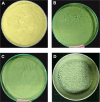Optimization of Metarhizium koreanum MN031-Mt 46: Nutritional Supplementation to Improve Conidia and Cuticle-Degrading Enzyme Production by Solid-State Fermentation
- PMID: 40295220
- PMCID: PMC12089957
- DOI: 10.4014/jmb.2412.12079
Optimization of Metarhizium koreanum MN031-Mt 46: Nutritional Supplementation to Improve Conidia and Cuticle-Degrading Enzyme Production by Solid-State Fermentation
Abstract
This study aimed to evaluate five different mixed agricultural wastes as potential substrates for solid-state fermentation (SSF) to produce conidia of Metarhizium koreanum MN031-Mt 46. Single-factor experiments and a Box-Behnken design (BBD) were employed to optimize the fermentation conditions for enhanced conidia yield. Results indicated that a mixed substrate comprising broken rice and rice bran significantly enhanced the optimal production of aerial conidia of MN031-Mt 46. Optimal fermentation conditions established through response surface methodology (RSM) revealed that with the addition of shrimp shell waste to the mixed substrate, conidia production increased to 8.45 × 108 conidia per gram of dry substrate at 26.19°C temperature, 39.76% moisture, and 1.45% of shrimp shell waste after 301.87 h of incubation. Enhanced conidia performance indices were observed, including higher conidia weight, increased water content, and reduced residue post-harvest. The optimized fermentation conditions resulted in enhanced cuticle-degrading enzymatic activities, with maximum activities of 58.78 ± 2.29 U g-1 ds for protease, 126.57 ± 6.47 U g-1 ds for lipase, and 58.32 ± 0.78 U g-1 ds for chitinase. These findings highlight the potential and versatility of mixed SSF using cost-effective agricultural waste for biopesticide and hydrolytic enzyme production, while promoting sustainable waste management and environmental pollution control, aligning with circular economy principles.
Keywords: Metarhizium koreanum; cuticle-degrading enzyme; performance indices; response surface methodology; solid-state fermentation.
Conflict of interest statement
The authors have no financial conflicts of interest to declare.
Figures






Similar articles
-
Production of Conidia by the Fungus Metarhizium anisopliae Using Solid-State Fermentation.Methods Mol Biol. 2016;1477:61-9. doi: 10.1007/978-1-4939-6367-6_6. Methods Mol Biol. 2016. PMID: 27565492
-
Optimization and scale-up of α-amylase production by Aspergillus oryzae using solid-state fermentation of edible oil cakes.BMC Biotechnol. 2021 May 4;21(1):33. doi: 10.1186/s12896-021-00686-7. BMC Biotechnol. 2021. PMID: 33947396 Free PMC article.
-
Rice recycling: a simple strategy to improve conidia production in solid-state cultures.Lett Appl Microbiol. 2022 Mar;74(3):385-394. doi: 10.1111/lam.13614. Epub 2021 Dec 13. Lett Appl Microbiol. 2022. PMID: 34825719
-
Growth kinetic and nitrogen source optimization for liquid culture fermentation of Metarhizium robertsii blastospores and bioefficacy against the corn leafhopper Dalbulus maidis.World J Microbiol Biotechnol. 2020 Apr 28;36(5):71. doi: 10.1007/s11274-020-02844-z. World J Microbiol Biotechnol. 2020. PMID: 32350696
-
Optimization of media composition and growth conditions for production of milk-clotting protease (MCP) from Aspergillus oryzae DRDFS13 under solid-state fermentation.Braz J Microbiol. 2020 Jun;51(2):571-584. doi: 10.1007/s42770-020-00243-y. Epub 2020 Mar 24. Braz J Microbiol. 2020. PMID: 32212055 Free PMC article.
References
-
- Tang FH, Lenzen M, McBratney A, Maggi F. Risk of pesticide pollution at the global scale. Nat. Geosci. 2021;14:206–210. doi: 10.1038/s41561-021-00712-5. - DOI
-
- EEA. 2023. Biopesticide. EPA; Research Triangle Park, NC, USA.
-
- Bettiol W. Biopesticide use and research in Brazil. Outlooks on Pest. Manag. 2011;22:280–283. doi: 10.1564/22dec10. - DOI
MeSH terms
Substances
LinkOut - more resources
Full Text Sources

